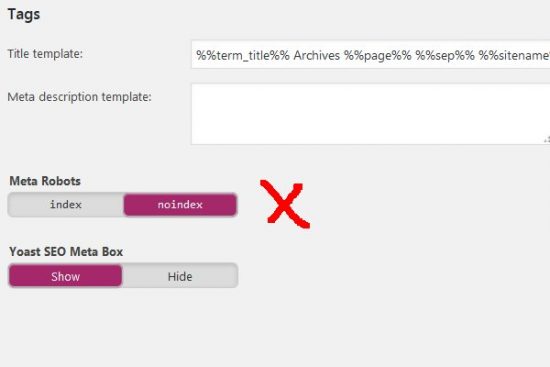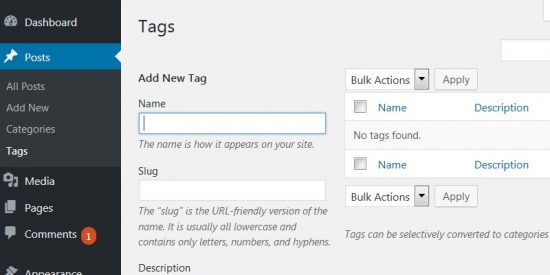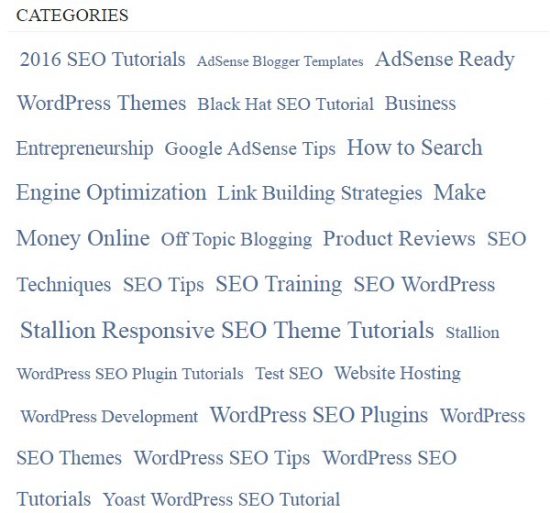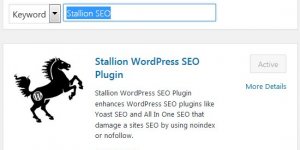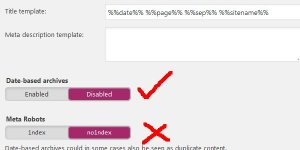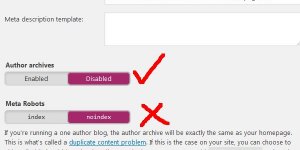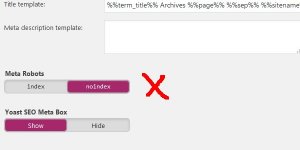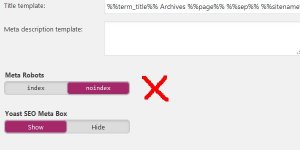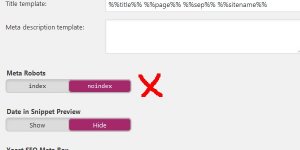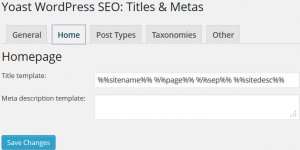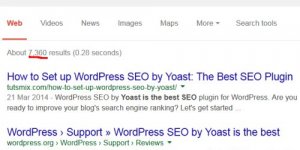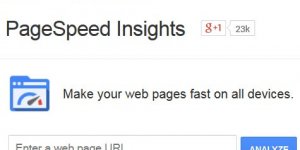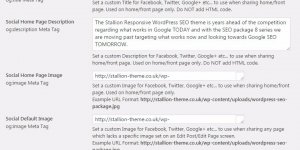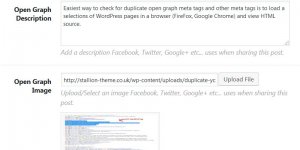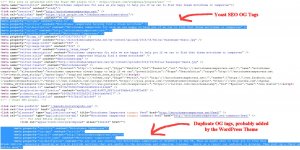The Yoast WordPress SEO Plugin Noindex Tags Tutorial article is part of a series of SEO tutorials to support the Stallion WordPress SEO Plugin and the Stallion Responsive WordPress SEO Theme.
Can also be used by Yoast WordPress SEO Plugin users to check if they have set any damaging Yoast Noindex robots meta tag options.
This WordPress SEO tutorial covers the Stallion WordPress SEO Plugin – Yoast WordPress SEO Plugin Noindex Tags Warning and the Stallion Responsive Theme – Yoast WordPress SEO Plugin Noindex Tags Warning.
Return to the main Yoast WordPress SEO Plugin Warnings article or the main Stallion WordPress SEO Plugin Documentation article.
Yoast WordPress SEO Plugin Noindex Tags Warning
If under the “Stallion WordPress SEO Plugin” : “SEO Plugin Warnings” Tab : “Yoast WordPress SEO Plugin Warnings” you see the following SEO warning:
“Titles and Metas – Taxonomies : Tags”
“Meta Robots: noindex”
You have a serious search engine indexing issue on your WordPress site regarding your WordPress Tags.
While you have this SEO warning, the Yoast WordPress SEO Plugin is stopping all search engines from indexing your WordPress Tags!!!
Yoast SEO : Titles and Metas – Taxonomies : Tags
To receive this Stallion SEO warning you have set under the Yoast SEO plugin options
“SEO” : “Titles and Metas” – “Taxonomies” Tab : Under “Tags”
Meta Robots: noindex
The noindex robots meta tag stops the webpage from being indexed in Google etc…, as long as this option is set none of your WordPress Tags will be found for relevant searches in any search engines including Google!
Although the noindex robots meta tag doesn’t stop the link benefit (PageRank : PR) from flowing through the Tags to the WordPress Posts (Posts will still be indexed and gain link benefit via the Tags links), the link benefit spent on indexing the tags (~15% of the link benefit flowing into the tags) is wasted!
When noindex is set the ~15% of link benefit that would normally be used to rank the Tags for relevant SERPs does nothing, it’s wasted!
Noindex Tags Wastes Link Benefit
You may have read setting a noindex robots meta tag on your Tags is a sensible SEO strategy, it isn’t. It just wastes the link benefit (PageRank : PR) which would be used to rank the Tag archives for relevant SERPs.
Since Tag archives tend to be linked sitewide (they are better linked internally than most WordPress Posts on most sites) that’s a serious waste of link benefit in they are noindexed! If you have say 50 Tags, noindexing them using the Yoast Noindex option would be the equivalent of selecting your 50 most linked webpages on your WordPress site and deciding you no longer want Google to send them any traffic: why would you do that???
Although in the Stallion WordPress SEO Plugin under the Not Index tab I’ve added the similar Block All Tags option, it’s highlighted in red to indicate it’s NOT a recommended option: I own over 100 WordPress sites, I’ve NEVER blocked a tag from being indexed, admittedly I don’t use tags, but I’ve never blocked a category.
If a Tag isn’t worth indexing it’s because you haven’t search engine optimized it, if you can’t optimize it, delete it: the best SEO strategy is to aim for ALL webpages on a site to target at least one SERP each or serve another purpose. For example a contact page is not much SEO value, but it serves a user purpose, on the other hand a monthly archive has no SEO value (costs loads of link benefit to index them for no gain) and not much use to visitors (delete them).
I cannot think of a single GOOD SEO reason why a webmaster would use this Yoast noindex option on tags?
Why would anyone want ALL their Tags not indexed in Google etc…?
See why categories and tags are not duplicate content.
Depending upon your WordPress SEO strategy setting the Yoast Noindex Tags option could result in an enormous amount of wasted link benefit, or have pretty much no impact at all. If you have no tags, noindexing tags has no effect on the other hand if you have hundreds of tags, noindexing them is seriously wasteful link benefit wise!
WordPress SEO Tutorial : Why I Never Create WordPress Tags
Slight WordPress SEO diversion to explain why I never create tags.
Unlike WordPress Categories (see the equivalent Yoast WordPress SEO Noindex Categories Tutorial) the WordPress Tag archives are optional. If the WordPress user doesn’t add tags to new Posts, there won’t be any tag archives to link to: this is an SEO strategy I use, I rarely if ever create WordPress tags. For example this site with almost 300 WordPress Posts spread over 25 Categories has no Tags (see screenshot from this sites Tags admin page below).
A WordPress Tag free SEO strategy recognizes Tag archives are for all intense and purposes the same as Category archives (the HTML output is pretty much the same) and if you create search engine optimized Categories there’s no need to add Tags as well. All WordPress Posts by default have to be added to one Category, being added to one Category is all a WordPress Post needs to be found and indexed by Google and other search engines.
For example this WordPress Post is added to 2 Categories (and no Tags), specifically the Stallion WordPress SEO Plugin Tutorials Category and the Yoast WordPress SEO Tutorial Category. It could also be added to the Stallion Responsive SEO Theme Tutorials Category since the article is related to the Stallion Responsive theme features as well (the Stallion WordPress SEO Plugin SEO Warnings are built into the theme as well), BUT I already have a lot of tutorials in that Category, so…
For a site with around 300 Posts being added to two Categories is more than enough (a lot of posts are added to just one category). Take into account if you add a Post to say 6 Categories (or category/tags : 2 categories and 4 tags for example) and you add a sitewide Category Widget (and Tags Widget), that’s a LOT of sitewide links to archives and this can have a negative SEO impact on specific Posts SEO targeting of content.
Yes having lots of categories/tags spreads link benefit through a WordPress site, but you are also going to have a LOT of anchor text from the Categories Widget (and Tags Widget) on every page of the site. The screenshot below shows this sites Categories Widget anchor text (I use the Tags Cloud Widget rather than the Categories widget for displaying all 25 Categories).
If I had the Categories Tags Cloud Widget loaded sitewide** that’s all that text (anchor text) loaded on every page including on all your important WordPress Posts!
**The Stallion Responsive Theme includes silo SEO widget features, Stallion Responsive can set which sections of the site a widget loads on and I set the Categories to NOT load on WordPress Posts: you’ll understand why as you read on.
This is all the anchor text as of November 1st 2016 from the Categories Tag Cloud widget:
2016 SEO Tutorials AdSense Blogger Templates AdSense Ready WordPress Themes Black Hat SEO Tutorial Business Entrepreneurship Google AdSense Tips How to Search Engine Optimization Link Building Strategies Make Money Online Off Topic Blogging Product Reviews SEO Techniques SEO Tips SEO Training SEO WordPress Stallion Responsive SEO Theme Tutorials Stallion WordPress SEO Plugin Tutorials Test SEO Website Hosting WordPress Development WordPress SEO Plugins WordPress SEO Themes WordPress SEO Tips WordPress SEO Tutorials Yoast WordPress SEO Tutorial
That’s a lot of anchor text (75 words) and anchor text is very important SEO wise.
Consider this SEO tutorial Post, it’s titled “Yoast WordPress SEO Plugin Noindex Tags Tutorial” and those are the sort of keywords we want Google to consider important for this webpage. Look through the Categories Tag Cloud Anchor Text and see how much does and does not relate to this Post SEO wise.
Related to this Post
SEO Tutorials WordPress SEO Tutorial SEO SEO SEO SEO WordPress Tutorials Stallion WordPress SEO Plugin Tutorials SEO WordPress WordPress SEO Plugins WordPress SEO WordPress SEO WordPress SEO Tutorials Yoast WordPress SEO Tutorial
Slightly Related
2016 Black Hat Tips How to Themes Google Search Engine Optimization Link Building Strategies Stallion Responsive SEO Theme Test Themes Tips Website Training
Not Related At All
AdSense Blogger Templates AdSense Ready Business Entrepreneurship AdSense Tips Make Money Online Off Topic Blogging Product Reviews Techniques Hosting Development
This site is heavily niched towards WordPress SEO topics, so this Post wouldn’t be too badly affected by that sitewide anchor text, but the articles in the AdSense and Make Money categories are going to have a LOT of anchor text that’s got no relationship to the Posts content. That’s not good SEO wise, in a perfect SEO world all links anchor text would support the webpage the links are on: so for this post in a perfect SEO world ALL links would link to content about “Yoast, WordPress, SEO, Plugin, Noindex, Tags, Tutorial” and little else (would be extreme silo SEO niching of links, which isn’t realistic).
I recognize this SEO problem so use the Stallion Responsive theme SEO feature to NOT display all the category links on Posts (most WordPress users won’t have this silo SEO feature), but I also try to limit the number of categories (and tags) to a minimum. If all Posts where added to 6 categories/tags I’d have to create more categories/tags and this would significantly increase the amount of category/tag based anchor text: would also mean more link benefit being used on categories and tags and not on Posts.
It’s a balance between usability and SEO, we need to categorize our content so users (and search engines) can easily find it, but we also have to take into account specific Post SEO targeting of content (all the anchor text on the Posts).
The Popular Articles widget (right sidebar) is also silo SEO niched (another Stallion Responsive theme feature), it only shows Posts from the categories (and tags) this Post is part of: so Posts from these two categories only – Stallion WordPress SEO Plugin Tutorials Category and the Yoast WordPress SEO Tutorial Category. Note the anchor text of the Popular Articles links is highly relevant to this Posts content, it helps this Post SEO wise, go to the Home page or another Post (in a different category) and the Popular Article links change to match that Posts content.
In summary creating a lot of tags (and/or categories) might sound like a good SEO strategy (more links to Posts), but it’s at a significant SEO cost, better to limit archives to a minimum and allow more SEO benefit to concentrate on WordPress Posts.
Yoast WordPress SEO Tutorials
- Yoast SEO Plugin Review
- Yoast SEO Plugin Warnings
- Yoast SEO Title Tags
- Yoast SEO Noindex Date Archives
- Yoast SEO Noindex Author Archives
- Yoast SEO Noindex Tags
- Yoast SEO Noindex Categories
- Yoast SEO Plugin Noindex Pages
- Yoast SEO Plugin Noindex Media
- Yoast SEO Noindex Posts
- Yoast SEO Paged Comments
- Is Yoast SEO the Best WordPress SEO Plugin?
- Which is the Best WordPress SEO Plugin?
David Law


